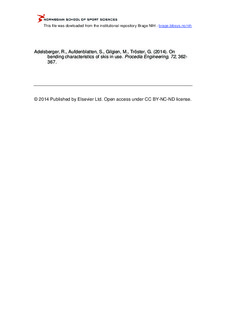| dc.contributor.author | Adelseberger, Rolf | |
| dc.contributor.author | Aufdenblatten, Sämy | |
| dc.contributor.author | Gilgien, Matthias | |
| dc.contributor.author | Tröster, Gerhard | |
| dc.date.accessioned | 2015-03-20T10:59:37Z | |
| dc.date.available | 2015-03-20T10:59:37Z | |
| dc.date.issued | 2014 | |
| dc.identifier.citation | Procedia Engineering. 2014, 72, 362-367 | nb_NO |
| dc.identifier.uri | http://hdl.handle.net/11250/279968 | |
| dc.description | © 2014 Published by Elsevier Ltd. Open access under CC BY-NC-ND license. | nb_NO |
| dc.description.abstract | Measuring ski deflection while skiing allows the characterization of essential aspects of the complex interplay between the skier's performance and the interaction of the ski with the snow. This provides an opportunity to optimize skis with regard to skiers’ skills and athletic ability, thus improving skiing performance. To establish an analysis system, we developed, characterized and tested a system capable of measuring ski deflection while skiing. Using competition-type slalom skis, we applied 30 strain gauge sensors - 15 on each ski. The strain gauges sampled data at 65 Hz and the readings were translated into deflection estimates. This was done by validating the system using a specialized bending machine equipped with a laser sensor system to accurately track the changes in ski shape with increasing applied force. We sampled strain gauge data while the bending apparatus deformed the ski. The RMS error of our ski-shape estimates relative to laser-measured data was 11 mm. In on slope tests, the center of mass (CoM) position and speed of a skier were acquired using a highly accurate differential Global Navigation Satellite System (dGNSS) at 50 Hz and a pendulum model. From this data we estimated the CoM turn radii of carved turns. During the ski tests, the bending radii along the ski over time were obtained from strain gauge data and analyzed for each carved turn. We observed smaller radii relative to the path radii at the tip of a ski. We further analyzed the correlation between ski turn radius from deflection measurements and the CoM turn radius. The RMS error between radii calculated from deflection measurements and CoM radii obtained with a high resolution dGNSS was on average 1.26m, with the smallest error being 0.78m. We tested our system on a hard-snow slope and a soft-snow slope. Our system has manageable technological complexity and is potentially suitable as a training tool or for use in ski-fitting for skiers of various skill levels. | nb_NO |
| dc.language.iso | eng | nb_NO |
| dc.publisher | Elsevier | nb_NO |
| dc.subject | ski | nb_NO |
| dc.subject | sensor system | nb_NO |
| dc.subject | GPS | nb_NO |
| dc.subject | bending sensors | nb_NO |
| dc.subject | field test | nb_NO |
| dc.subject | prototype | nb_NO |
| dc.title | On bending characteristics of skis in use | nb_NO |
| dc.type | Journal article | nb_NO |
| dc.type | Peer reviewed | nb_NO |
| dc.subject.nsi | VDP::Technology: 500 | nb_NO |
| dc.source.journal | Procedia Engineering | nb_NO |
| dc.description.localcode | Seksjon for fysisk prestasjonsevne / Department of Physical Performance | nb_NO |
